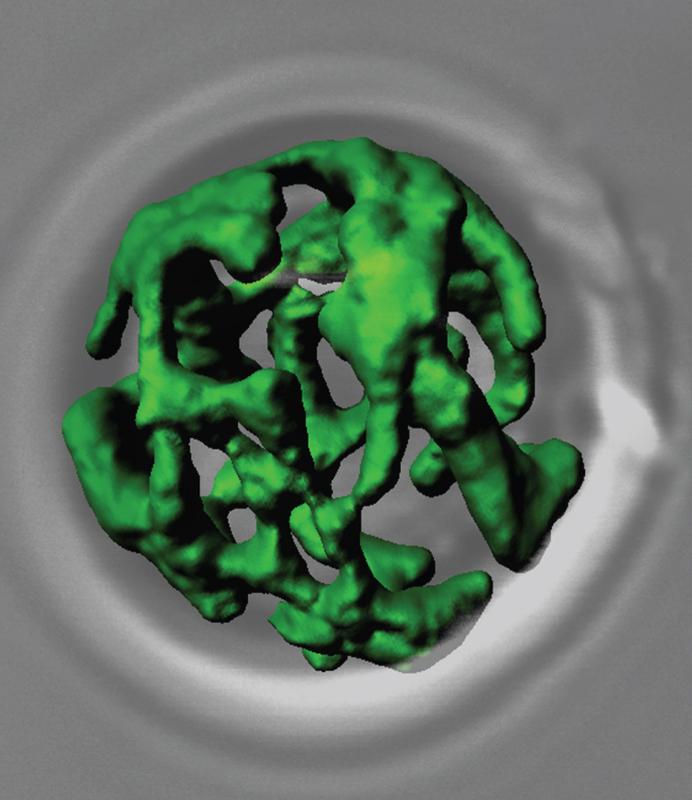New Import Pathway into the Cell’s Powerhouses

Networklike structure of mitochondria (green) from the model organism bakers' yeast. Credit: Research group Meisinger
Mitochondria serve as the powerhouses of the cell, converting the energy stored in foods into a form cells can use. When this important task fails, it can result in numerous diseases, particularly those affecting organs with a high energy consumption like the brain or the heart.
The Freiburg biochemistry professor Chris Meisinger, the Freiburg molecular medicine researcher Dr. Nora Vögtle, and the Freiburg pharmaceutical scientists Dr. Martin Holzer and Dr. Michael Keller have discovered a new import pathway proteins use to reach the mitochondria.
The common assumption among researchers up until now has been that proteins are always transported into the mitochondria via so-called import machines. The newly discovered import pathway, by contrast, is independent of the import machines. The research team published the study in the Journal of Cell Biology.
Mitochondria need more than 1000 different proteins to fulfill their vital tasks for the cells. Most of these proteins are produced in the cellular fluid and then imported into the mitochondria. The powerhouses of the cell have import machines in their membranes for this purpose.
These import machines, which are for their part also composed of various proteins, act as gatekeepers and sluices, allowing the mitochondria to import the new proteins they need from the cellular fluid.
The research team found a new import pathway for the protein Ugo1 that does not pass through the import machines. Ugo1 is localized in the outer membrane of mitochondria. The scientists succeeded in reconstructing the protein’s transport pathway in artificial membranes consisting of lipids, fat-like substances present in the membranes of mitochondria.
The import no longer functioned when the researchers constructed the artificial membrane without a particular lipid only present in small amounts, phosphatidic acid. Moreover, the scientists demonstrated that living cells with an elevated concentration of phosphatidic acid also contain a higher amount of Ugo1. “This study shows that contrary to what has previously been assumed, lipids can take on specific and active functions in the import of mitochondrial proteins,” says Chris Meisinger.
Chris Meisinger is a research group leader at the Institute of Biochemistry and Molecular Biology of the University of Freiburg as well as a member of the Freiburg Cluster of Excellence BIOSS Centre for Biological Signalling Studies. Nora Vögtle is a member of Meisinger’s research group. Martin Holzer and Michael Keller conduct research at the Institute of Pharmaceutical Technology and Biopharmacy of the University of Freiburg.
Original publication:
Vögtle, F.N., Keller, M., Taskin, A.A., Horvath, S.E., Guan, X.L., Prinz, C., Opalinska, M., Zorzin, C., van der Laan, M., Wenk, M.R., Schubert, R., Wiedemann, N., Holzer, M., and Meisinger, C. (2015). The fusogenic lipid phosphatidic acid promotes the biogenesis of mitochondrial outer membrane protein Ugo1. Journal of Cell Biology.
Contact:
Prof. Dr. Chris Meisinger
Institute of Biochemistry and Molecular Biology
University of Freiburg
Phone: +49 (0)761 / 203 – 5287
E-Mail: chris.meisinger@biochemie.uni-freiburg.de
Media Contact
More Information:
http://www.uni-freiburg.de/All latest news from the category: Life Sciences and Chemistry
Articles and reports from the Life Sciences and chemistry area deal with applied and basic research into modern biology, chemistry and human medicine.
Valuable information can be found on a range of life sciences fields including bacteriology, biochemistry, bionics, bioinformatics, biophysics, biotechnology, genetics, geobotany, human biology, marine biology, microbiology, molecular biology, cellular biology, zoology, bioinorganic chemistry, microchemistry and environmental chemistry.
Newest articles

“Nanostitches” enable lighter and tougher composite materials
In research that may lead to next-generation airplanes and spacecraft, MIT engineers used carbon nanotubes to prevent cracking in multilayered composites. To save on fuel and reduce aircraft emissions, engineers…

Trash to treasure
Researchers turn metal waste into catalyst for hydrogen. Scientists have found a way to transform metal waste into a highly efficient catalyst to make hydrogen from water, a discovery that…

Real-time detection of infectious disease viruses
… by searching for molecular fingerprinting. A research team consisting of Professor Kyoung-Duck Park and Taeyoung Moon and Huitae Joo, PhD candidates, from the Department of Physics at Pohang University…





















